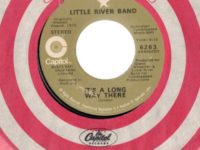The Little River Band is back in the news — though the headlines are not focusing, as they’d no doubt hoped, on the group’s 40th anniversary celebration. Instead, a now-canceled booking on the Tonight Show Starring Jimmy Fallon turned into a very public argument over the right to continue without original members who helped create their best-known songs.
There were, of course, many. In fact, the Little River Band placed 11 tracks in the Top 40 in the late 1970s and early 1980s, becoming one of the most successful acts to come from Down Under. Yet, despite offering a note-perfect blending of sweeping vocals and polished musicianship — smooth, approachable, ear-wormy — they were never blessed with much critical applause.
As such, between that age-old rock snobbery and this new round nasty squabbling, it’s easy to forget what made the Little River Band great in the first place. We decided — wait for it — that we’d offer a cool change. Here are some LRB moments, many of them deep cuts, that still cut through the clutter …
“RED-HEADED WILD FLOWER,” (SLEEPER CATCHER, 1978): Some rock acts start out edgy, later mellowing out to adult contemporary … sometimes blissfully, sometimes not. Little River Band was playing the adult contemporary format from the word “go,” and in its classic configuration of original band leaders Glenn Shorrock, Beeb Birtles and Graeham Goble, they provided some of the best the genre had to offer in the late 1970s.
That’s not to say they couldn’t rock out once in a while, which they did on the track that immediately followed their signature hit “Reminiscing” on Sleeper Catcher. “Red-Headed Wild Flower” was co-written by Birtles and its growling, slightly twangy guitar riff seemed to anticipate by three years the power pop of his former Zoot bandmate Rick Springfield. Shorrock’s voice proves to be plenty strong enough to rock it, too, but it’s those sweet Shorrock/Birtles/Goble harmonies that make even harder stuff like this unmistakably Little River Band. The entry after the first verse of George McArdle, a fantastic bass player who only appeared on three LRB albums, kicks the groove into high gear and lead guitarist David Briggs turns in a nice, if awfully derivative, wailing lead.
It always comes back to those harmonies, though, skating over the loud guitars. Just in case anybody still forgot what made this band go, the final chorus ends with all those instruments yanked out of the mix, leaving just those three voices to finish the last chord, tweaked up a notch (by Beeb Birtles?) right at the last second. Listening to this song today, I still relish getting to that perfect ending. — S. Victor Aaron
“THE OTHER GUY,” (GREATEST HITS, 1982): In 1980, Graeham Goble produced John Farnham’s Uncovered album, and the experience planted a seed with Goble. When a disgruntled Glenn Shorrock departed Little River Band following 1981’s Time Exposure album, the first person Goble thought of to replace Shorrock was John Farnham. Farnham showed up just in time to record 2 songs — “The Other Guy” and “Down On the Border,” both of which augmented the LRB classics on their Greatest Hits release.
Of all the songs LRB recorded during Farnham’s brief tenure as their lead singer, “The Other Guy” is easily their best. Farnham’s voice blends seamlessly with LRB’s tight vocal harmonies, and the chemistry was undeniable. Unfortunately, it wouldn’t last — perhaps because Farnham’s voice is more distinct than Shorrock’s (some might argue better as well). The lion’s share of material he recorded with them on The Net, Playing to Win, and No Reins (1983-86) didn’t so much sound like Little River Band as it sounded like John Farnham featuring special guests Little River Band.
Where Glenn Shorrock’s voice was a pleasant lead, it also blended seamlessly with the tight vocal harmonies of Graeham Goble, Beeb Birtles and, at times, David Briggs and later Wayne Nelson. Farnham’s voice was a force in and of itself, something that stuck out like a sore thumb from those tight vocal harmonies. But for a brief moment in time when he first joined the band, he too enjoyed that seamlessness with his then-new band mates. To this day “The Other Guy” is a delight to listen to. — Perplexio, from DancingAboutArchitecture and The Review Revue
“IT’S A LONG WAY THERE,” (LITTLE RIVER BAND, 1975): The opening salvo from Little River Band’s eponymous American debut is almost their prog-rock statement, but not quite. While it never fully crosses the border into the land of prog it’s definitely the most non-commercial track LRB ever put on vinyl. It’s also one of their best.
At over eight minutes long, “It’s A Long Way There” features tempo changes, extended instrumental breaks in which they get to show off their musicianship, and a real string section. (No synths allowed!) What prevents the song from overstaying its welcome or becoming pretentious are LRB’s usual assets. They know just what this smoldering track needs to keep the embers burning without setting it on fire. Sophisticated without being too artsy the song is bolstered by a dynamite lead singer accompanied by some of the best harmonies in the business. — Charlie Ricci, from www.Bloggerhythms.com
“DAYS ON THE ROAD,” (from DIAMANTINA COCKTAIL, 1977): Graeham Goble wasn’t done writing about life as a traveling musician when he penned their first American hit “It’s A Long Way There,” he followed it up a year later with another strings-bolstered tune, “Days On The Road.” Originally part of LRB’s Australian-only After Hours album (1976) but rejected by their American distributor Capitol Records for being too downcast, “Days” was nonetheless rescued from that sophomore effort and placed on the American version of their third album, the terrific Diamantina Cocktail.
The orchestration is laid on thick for a folk-rock song but it’s also arranged beautifully. Glenn Shorrock’s soulful croon nails it, too, and when he pleads he “almost died there” it’s nearly believable. Of course, the harmonies put a rich layer of icing on the cake. A tart succinct, bluesy guitar solo from Ric Formosa befits the song’s somber mood, and a lofty flute solo by hired hand Graham Lyall also contributes to the heavy-hearted mood.
It’s a recycled topic for Graeham Goble, but there’s no diminishing returns with “Days On The Road.” — S. Victor Aaron
“SANITY’S SIDE,” (SLEEPER CATCHER, 1978): This entire album has an easy-going breeziness to it that certainly helped make it one of LRB’s 2 most successful albums (the other being its follow-up, 1979’s First Under The Wire). While “Lady” and “Reminiscing” were the hits, “Sanity’s Side” remains a favorite album cut — starting with David Briggs’ stellar guitar work. The tune also features some of Glenn Shorrock’s best vocals amid those trademark tight LRB harmonies, and lyrics that most of us can relate to from to time.
When I find my own life getting a bit hectic, this song is a gentle reminder that I’m not the only one who has felt that way. Sometimes just knowing you’re not alone in your experiences makes them a bit easier to bear — until you too are “carried back to sanity’s side.” — Perplexio
“SO MANY PATHS,” (SLEEPER CATCHER, 1978): An exuberant track from LRB’s fourth album, “So Many Paths” epitomizes what snot-nosed critics always hated most about any mainstream band from the classic-rock era. However, the view from this vantage point is that everything the press disliked about the song is exactly what is great about it.
This fast-paced opus featured an excellent Glenn Shorrock lead vocal, great harmonies, a catchy melody — and, worst of all, a positive message: “There are so many paths up the mountain, nobody knows all the ways.” Those of us who managed to both embrace and look beyond the music that “Rolling Stone” championed knew that Little River Band were among the elite artists who were playing in the middle of the road. They were not corporate sellouts who only manufactured music that would give them the biggest bang for their buck and that is why “So Many Paths” works. Beeb Birtles, Graeham Goble, and Glenn Shorrock gave the world the music they were best suited to play. — Charlie Ricci
“I DREAM ALONE,” (GET LUCKY, 1990): After John Farnham’s departure following the 1986 No Reins album, Glenn Shorrock returned as lead singer for a couple of enjoyable but generally ignored projects, Monsoon and Get Lucky. On 1990’s Get Lucky, Shorrock teamed with former Little River Band drummer Derek Pellici for “I Dream Alone,” a poignant ballad that details an Australian immigrant’s journey.
The song also tips a hat to the Aboriginal roots of Australia with the theme of “dreams” and “dreaming.” The lyrics are rich with imagery that is familiar to most of us — whether from Down Under or not. And for the 4 minutes 51 seconds, as I “share my life with the immigrants and ramblers, drink my wine with the middle men and the gamblers, spend my time with schemers on the phone, and dream alone,” I too am Australian. — Perplexio





Please read: http://www.littleriverband.com/wayne-nelson-replies-to-former-lrb-members-and-the-australian-press-tell-the-truth/